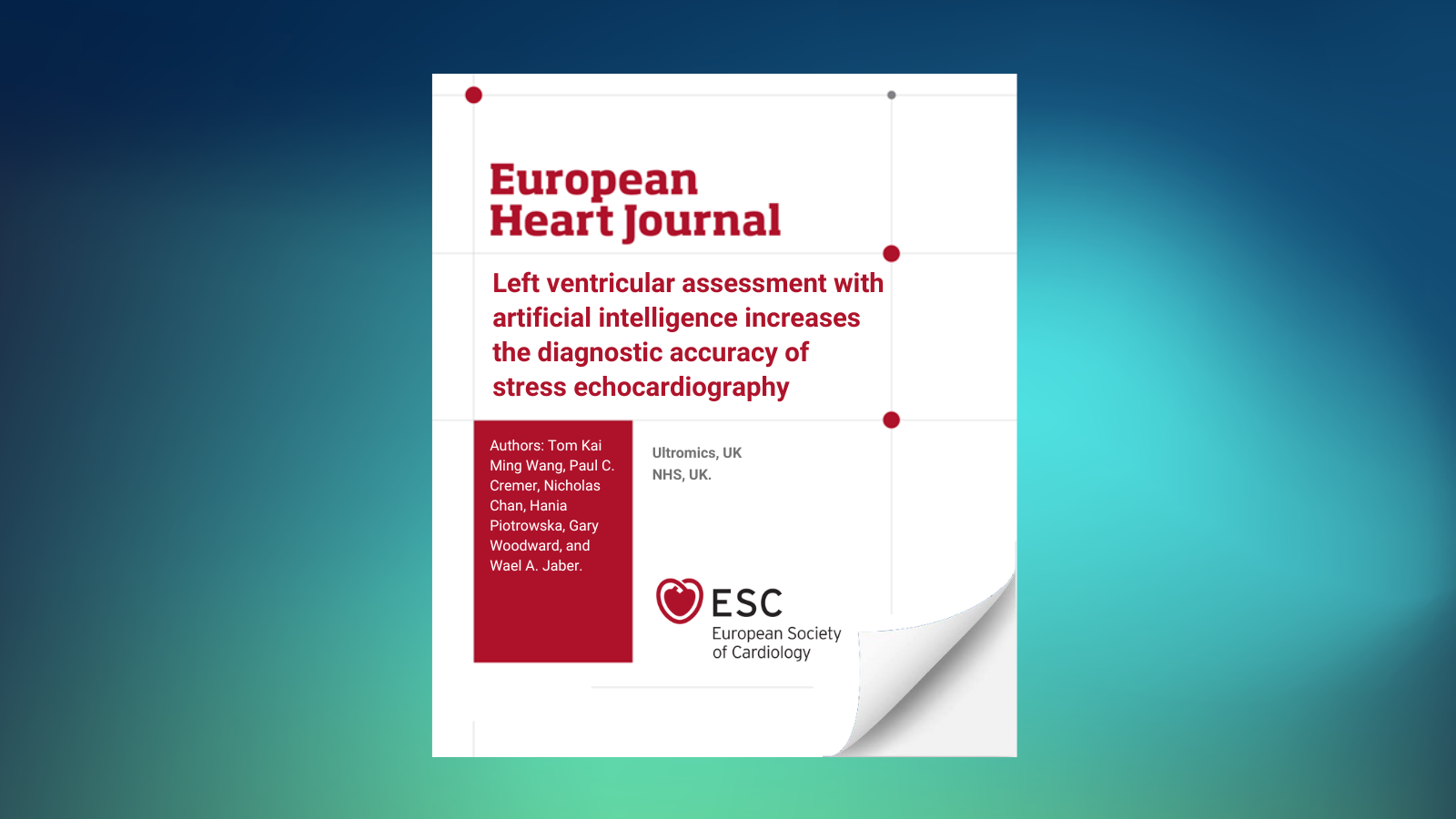
Ultromics increases diagnostic accuracy of stress echocardiography, in six NHS hospitals
- | By Ultromics
- Press Release
EchoGo Core, an AI-powered platform from Ultromics, utilizes artificial intelligence (AI) and cloud technology to deliver fully automated analysis of an echocardiogram with significantly higher precision and accuracy compared to manual as well as semi-automated analysis.
A recent study by Ultromics has established that the diagnostic accuracy of Stress Echocardiography (SE) can be increased by left ventricular assessment with AI. The findings of this study were published by the European Society of Cardiology.
Ultromics collaborated with Buckinghamshire Healthcare NHS Trust, Great Western Hospitals NHS Foundation Trust, Milton Keynes University Hospital NHS Foundation Trust, John Radcliffe Hospital, Oxford; Royal United; Royal Berkshire NHS Foundation Trust, and St George’s University Hospitals NHS Foundation Trust, London for this study.
EchoGo Core, the AI platform from Ultromics, has been validated by numerous globally acclaimed researchers and academic and clinical institutions. This cloud-based technology provides precise and fully automated analysis of the left ventricle, which is considered to be extremely critical for diagnosing and prognosing heart failure. It has already received FDA clearance and CE mark, and has been used with great results by many provider organizations throughout the US and UK.
Stress echo is a widely performed, accessible, and cost-effective procedure for diagnosis and risk stratification of patients with known or suspected coronary artery disease (CAD)1. However, the inherent reliance on subjective assessment of wall motion scoring can lead to significant variability2. The use of quantitative measures of left ventricular systolic function, including left ventricular ejection fraction (LVEF) and global longitudinal strain (GLS) during stress echo may provide diagnostic accuracy for CAD3.
The aim of the study was to determine whether the diagnostic performance of stress echocardiography (SE) for coronary artery disease (CAD) detection can be increased by automatically calculating left ventricular ejection fraction (LVEF) and global longitudinal strain (GLS) utilizing AI. Ultromics’ EchoGo Core played an integral part in this elaborate clinical study.
The research involved the evaluation of SEs from 512 participants who underwent a clinically indicated SE (with or without contrast) for the investigation of of chest pain. In order to identify inducible ischaemia, Visual Wall Motion Scoring (WMS) was performed. SE images at rest and stress underwent AI contouring for automated calculation of AI-LVEF and AI-GLS with Ultromics EchoGo Core 1.0. Receiver operator characteristic curves and multivariable risk models were used to assess accuracy for identification of participants subsequently found to have CAD on angiography.
Ultromics’ AI algorithm was used for automated contouring of the endocardial border of every frame from the A4C and A2C views, automated identification of the end-diastolic and the end-systolic frames based upon the size of the enclosed area, and automated selection of the cardiac cycle. LVEF was measured using the modified Simpson’s biplane method of discs and GLS was measured using the average longitudinal strain from the A4C and A2C views3.
Participants with significant CAD were more likely to have abnormal WMS, AI-LVEF, and AI-GLS values at rest and stress (all P < 0.001). The areas under the receiver operating characteristics for WMS index, AI-LVEF, and AI-GLS at peak stress were 0.92, 0.86, and 0.82, respectively, with cut-offs of 1.12, 64%, and −17.2%, respectively. Multivariable analysis demonstrated that addition of peak AI-LVEF or peak AI-GLS to WMS significantly improved model discrimination of CAD3.
AI calculation of LVEF and GLS by contouring of contrast-enhanced and unenhanced SEs at rest and stress was feasible and independently improved the identification of obstructive CAD beyond conventional WMSI alone3.
Ultromics has shown that AI-calculated LVEF and GLS is able to provide independent and incremental predictive value to identify significant CAD beyond conventional risk factors and inducible ischaemia3. "A key strength of these findings is the increased availability of diagnostically relevant information without the requirement of advanced analysis skills or clinician time.” O’Driscoll, et al.
The lead author of this study was Dr. Jamie O’Driscoll, a Reader in Cardiovascular Physiology at Canterbury Christ Church University and Clinical Scientist in Cardiology at St George’s University Hospitals NHS Foundation Trust. Having achieved significant breakthrough as a researcher in the field of cardiac imaging, he has recently shifted his focus on incorporation of artificial intelligence technology into the clinical practice of echocardiography.
“This study demonstrated that automated AI quantification of LVEF and GLS in contrast-enhanced and unenhanced SE images is feasible both at rest and with different modes of stress in a multicentre study. These measures conferred additional independent prognostic information in participants with suspected obstructive CAD, above and beyond inducible wall motion abnormalities alone. These findings support the increased use of quantification in SE in order to improve its diagnostic performance and utility in identifying and managing CAD,” Dr. O’Driscoll. The published study by The European Society of Cardiology can be accessed here.
About Ultromics:
Ultromics is the leader in artificial intelligence for echocardiography enabling earlier detection and risk stratification of heart failure for better outcomes, lower costs, and improved patient care. All providers, regardless of their care setting, can now make precise, accurate, and timely diagnoses of heart failure with Ultromics’ AI technology. The cloud-based platform, EchoGo, offers a simple, secure and seamless way to augment your existing technology and workflow with fully automated, advanced echo analysis including critical advanced measures recommended by guidelines. The technology is FDA-cleared and trusted by world-renowned organizations such as Mayo Clinic and the NHS England. Learn more: https://www.ultromics.com
References:
- Senior R. Stress echocardiography for the diagnosis and risk stratification of patients with suspected or known coronary artery disease: a critical appraisal. Supported by the British Society of Echocardiography. Heart [Internet]. 20051;91:427–36.
- Pellikka PA, Arruda-Olson A, Chaudhry FA, Chen MH, Marshall JE, Porter TR, et al. Guidelines for Performance, Interpretation, and Application of Stress Echocardiography in Ischemic Heart Disease: From the American Society of Echocardiography. Journal of the American Society of Echocardiography [Internet]. 2020;33:1-41.e8.
- O’Driscoll JM, Hawkes W, Beqiri A, Mumith A, Parker A, Upton R, et al. Left ventricular assessment with artificial intelligence increases the diagnostic accuracy of stress echocardiography. Gimelli A, editor. European Heart Journal Open. 2022 Sep 1;2(5).
Curious about upcoming research and innovation?
Sign up to hear about the latest news.

